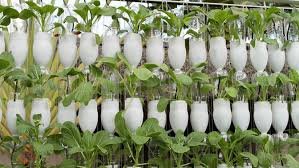Hydroponics is a subset of hydroponic culture, a method of growing undiluted plants with mineral nutrient solutions in a water-based solvent. Land plants can only be grown when their roots are exposed to the mineral solution, or they can be carried by an inert medium such as perlite or gravel.
Nutrients used in hydroponic systems can come from a variety of sources. These may include, but are not limited to, fish waste by-products, duck manure or purchased chemical fertilizers.
There are two main variations for each environment: top irrigation and top irrigation [specify]. For all techniques, most hydroponic tanks are now made of plastic, but other materials such as concrete, glass, metal, vegetable solids, and wood have also been used. Containers should exclude light to prevent the growth of algae and fungi in the nutrient solution.

STATIC SOLUTION CULTURE
In static solution cultures, plants are grown in nutrient solution containers such as Mason jars (normally used at home), plastic buckets, vats or tanks. The solution normally aerates gently but can not be aerated. If not aerated, the solution level is kept low enough to have enough roots above the solution to get enough oxygen. For each system, a hole is drilled in the tank cap. Only one tank can be assigned to a single system or several systems. The size of the tank can be increased with increasing size of the plant. A home system can be made from plastic food containers or ventilated glass jars provided by an aquarium pump, overhead pipe and aquarium valves. Transparent containers are covered with aluminum foil, butcher paper, black plastic or other light-preventing material to prevent algae growth. The nutrient solution is changed on a schedule, for example once a week, or when the concentration falls below a certain value determined by a conductivity meter. If the solution is below a certain level, add water or a fresh nutrient solution. A Mariotte bottle or a float valve can be used to automatically maintain the solution level. In the culture of the balsa solution, the plants are placed in a floating plastic film that floats on the surface of the nutrient solution. In this way, the level of solution never falls below the roots.
CONTINUOUS FLOW SOLUTION CULTURE
In the culture of the continuous solution, the nutrient solution constantly flows over the roots. It is much easier to automate than a static solution culture, as sampling and adjustment of temperature and nutrient concentrations can be done in a large storage tank that can potentially service thousands of plants. A popular variation is the Nutrient Film Technique (NFT), where a very shallow stream of water containing all of the dissolved nutrients needed for plant growth is returned to a coarse carpet through the bare roots of the plants. impermeable, which develops in the bottom of the canal. and it has an upper surface which, though wet, is in the air. Subsequently, an abundant supply of oxygen to the roots of the plants is provided. A properly designed NFT system is based on the use of the correct channel pitch, the correct flow rate, and the correct channel length. The main advantage of the NFT system over other forms of hydroponics is that plant roots are exposed to sufficient reserves of water, oxygen and nutrients. For all other forms of production there is a conflict between the supply of these needs, as excessive or insufficient quantities of a product lead to an imbalance of one or both. NFT provides a system from the ground up that can meet the three requirements for healthy plant growth at the same time, provided the simple NFT concept is always remembered and put into practice. The result of these advantages is that higher yields of high quality products are obtained during a longer culture period. One of the disadvantages of NFT is that the flow breaks are attenuated very little (eg power outages). But in general, it's probably one of the most productive techniques.
The same design features apply to all conventional NFT systems. Although gradients along the channels of 1: 100 have been recommended, in practice it is difficult to provide a base for the channels that is true enough to allow the nutrient films to flow without stagnating in locally depressed areas. Therefore, it is recommended to use gradients from 1h30 to 1h40. [18] This allows for minor irregularities in the surface, but even with these gradients, ponds and water retention can occur. The slope can be provided by the ground, benches or pillars can support the channels and provide the required pitch. Both methods are applied and depend on the local requirements, which are often determined by the location and requirements of the culture.
As an indication, the flow rates for each channel should be one liter per minute. [19] In plants, the flow rates can be less than half and the upper limit of 2 l / min is approximately above the maximum. Flow rates above these extremes are often associated with nutritional problems. Low growth rates of many cultures were observed when the channels are longer than 12 meters. In fast-growing cultures, tests have shown that even with sufficient oxygen content, nitrogen can be broken down in the entire stream. Therefore, the length of the channel should not exceed 10-15 meters. In cases where this is not possible, it is possible to eliminate the growth reduction by separating another nutrient in the middle of the stream and halving the flow at each outflow.
